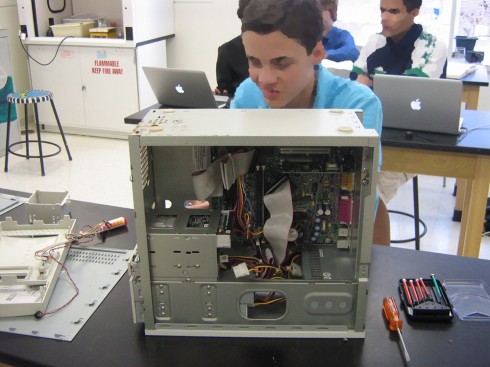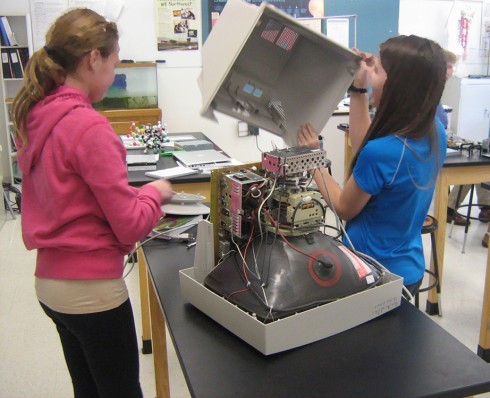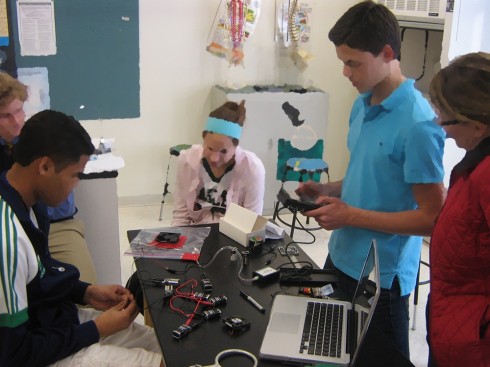We had a couple laptops recently donated to the Makerspace (thanks Ms. A) and I’ve installed Ubuntu’s Linux (20.04 LTS) to see if I could get them to be useful for my students. I particularly wanted to see how hard they’d be to set up for programming (especially given the issues I’ve had with python). They’re working quite well so far, and this is my record of what I’ve done to set them up.
Installing Ubuntu
Ubuntu makes it really easy to install their operating system; it’s the main reason it’s one of the more popular flavors of Linux. You can download the ISO and get instructions on how to create a USB installation stick on their page.
Getting System Information
inix is a nice tool to for finding information about your computer (which you sort-of need when you’re dealing with donated machines): what type of cpu, how much RAM, size of the hard drive and things like that. Install with:
sudo apt-get install inxiand to get the full set of information, run:
inxi -FExtremely useful, but I did not really need this to tell me that I needed to upgrade the hard drive. Swapping the hard disk drive (HDD) for a solid state drive (SSD) is one of the quickest and cheapest ways to upgrade an older system. I picked up a 120 Gb SSD for less than $20 and the computer is now an order of magnitude faster (though I’m down from 500 Gb).
Upgrading
The final step after installing the operating system is to update the software. Ubuntu runs an automatic update on your first boot. However, since I’ll be doing most of my installations from the command line, I run the update commands (just in case):
sudo apt updatesudo apt upgradeSetting up Python
Python 3.8.5 was installed by default, but I need the python package installer (pip) to install the modules I’ll need:
sudo apt install python3-pipNow I can install numpy (-U option to upgrade) for numerical stuff:
pip3 install -U numpyas well as, matplotlib:
pip3 install -U matplotliband vpython
pip3 install vpythonand for virtual environments (venv):
pip3 install virtualenvand the IDLE editor for python
sudo apt-get install idle3also the Thonny editor that makes using Raspberry Pi Picos much easier (especially for the pico LED strips)
sudo apt install thonnyNow we should be good to go.
git, github, and vs code
git: I’ve been using github.com for keeping my programming projects and GitHub Classroom for my programming class. The GitHub Desktop program is great for Windows and OSX, but does not exist for linux at the moment. So I needed to install git:
sudo apt install git-allVS Code is a pretty popular IDE for coding that I’ve been using for my computer programming class. It’s a Microsoft product that is designed to work closely with github repositories. You can download the .deb from
It’s usually saved in the ~/Downloads folder, so to install this should work:
sudo apt install ./Downloads/code*.debI usually test the VS Code installation with my ledPixelsPico repository because I want to make sure I can operate my Raspberry Pi Pico LED strips.
To get VS Code to be able to make commits and sync with the repository (you’ll have to test this with a repository of your own–or that you have permission to sync with) you’ll need to run the ‘git config –global user.email “you@example.com”‘ and ‘git config –global user.name “Your Name”‘ commands in the VS Code Terminal.
LaTeX
For typesetting beautiful documents (mainly for the equations) I use LaTeX.
Since I don’t want to worry about downloading LaTeX packages when I need something esoteric I install the full Tex Live distribution (Note: for texlive on Fedora use ‘texlive-scheme-full‘).
sudo apt-get install texlive-fullEditor: To use LaTeX we need an editor. I prefer TeXstudio:
sudo apt-get install texstudio- Folder with all files needed to test the typical things I do with LaTeX in a chapter format: LaTeX Demo Report.
NOTE: if you’re low on memory, you can install something like Miktex instead of Tex Live because it installs packages only when you need them. Also, some of my students who use Apple computers seem to find TexShop easier to set up than TexStudio.
Installing Additional Software
The basic Ubuntu installation comes with a lot of the free software I use, but, using the command line:
sudo apt install ...or the Ubuntu (or other package manager) Software tool, I added:
- [Atom] [depreciated]: text editor for coding (being depreciated unfortunately, I’ve been forced to use VS Code instead: see above, or Thonny: see below and above).
- Thonny: Coding editor for working with Raspberry Pi Picos in particular (may already be installed from the python section above).
- GIMP: for image editing
- Inkscape: for vector graphics
- OpenScad: for 3d Modeling (for printing)
- Shotcut: for video editing (it’s multi-platform). I’m trying this one for extracting time information from experiments (like ball drops). Can install with ‘sudo apt-get install shotcut’
UxPlay [Optional]: A crucial piece of software for online teaching that I had to install via the command line was, UxPlay, and you can see my variant of the installation instructions here. This program allows me to mirror my iPad to the computer.
The Rest
The rest is mostly tweaking the settings to your specifications (there’s even a program called Tweak you can install for extra settings).
Tweaks
I use this to enable hot-corners and customize the desktop interface.
sudo apt install gnome-tweak-toolsudo apt install gnome-shell-extensionsFonts
Added the student fonts following LinuxConfig’s instructions, specifically the section on “Manual system-wide font installation”, which just meant copying the folder with all the fonts to the “/usr/local/share/fonts/” directory.
php
I use php a lot so I’ve set it up so I can run php off the command line (I haven’t figured out how to use url parameters this way though).
sudo apt install php libapache2-mod-phpsudo apt install php-cligdebi
gdebi is a little application for installing .deb software. I’ve had enough hiccups with the Ubuntu Software tool, to find it useful to right click a downloaded .deb file and install it using gdebi. To install:
sudo apt install gdebiImager
The first thing I used gdebi to install was Imager, which is used to write the Raspberry Pi operating system to USB’s or SD cards. Download the imager .deb, right click and install using gdebi.
nmap
nmap maps your local network, which is useful if you have a bunch of Raspberry Pi’s around and need to figure out their IP addresses.
sudo apt-get install nmapTo use nmap to find all the raspberry pi’s on the local network use something like this, where you change the IP address (192.168.4.0) to whichever IP your computer is on, but switch the last number for 0:
sudo nmap -sP 192.168.4.0/24 | grep -in -B 2 'pi'



